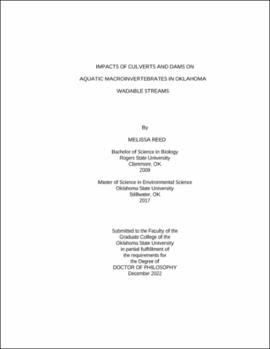| dc.contributor.advisor | Hoback, William | |
| dc.contributor.author | Reed, Melissa | |
| dc.date.accessioned | 2023-07-05T20:56:45Z | |
| dc.date.available | 2023-07-05T20:56:45Z | |
| dc.date.issued | 2022-12 | |
| dc.identifier.uri | https://hdl.handle.net/11244/337870 | |
| dc.description.abstract | Anthropogenic activities alter flowing water in many ways resulting in streams being among the most modified ecosystems worldwide. Humans cause the greatest effects to aquatic ecosystems by creating artificial structures to impede natural stream flow. The purpose of this research was to examine the impact artificial structures such as dams and culverts have on aquatic invertebrates and to test the effectiveness of homemade artificial substrate sampling devices. Dams alter discharge, temperature regimes, and disconnect upstream and downstream reaches causing changes in biological communities. Existing literature demonstrates that dams impact aquatic biota, including macroinvertebrates, but less is known about how far these impacts persist downstream of dams and whether the impact of multiple dams is cumulative. In addition, the release of hypolimnetic water from reservoirs alters downstream water quality, especially water temperatures and flow regimes, which often disrupts the natural stream community. Our first objective was to assess the effects of hypolimnetic releases and multiple dams on macroinvertebrates in a 19-km reach of the lower Mountain Fork River, a cold tailwater river, fragmented by three dams in southeastern Oklahoma. Culverts impact streams by narrowing the stream channel, preventing the movement of substrate and large woody debris, and causing erosion near the road crossing leading to subsequent sedimentation further downstream. Existing literature shows that culverts pose a threat to habitat connectivity and limit fish movement in lower order streams, but less is known about the impacts of culverts on aquatic macroinvertebrates. Therefore, our second objective was to investigate the effects of road culverts on the aquatic macroinvertebrate communities in two stream systems (Tallgrass prairie and Ozark Highlands) in eastern and northeastern Oklahoma. Finally, collecting aquatic invertebrates is an important part of monitoring ecosystem health in aquatic habitats. Artificial substrate sampling devices are constructed to attract aquatic organisms that attach to hard surfaces to hide from predators and are an established sampling method for aquatic invertebrates. Hester-Dendy devices are widely used in standard water quality monitoring programs and research; however, the devices are expensive ($22-38 each). Our third objective was to test homemade artificial substrate devices created from empty 500-milliliter plastic soda bottles. | |
| dc.format | application/pdf | |
| dc.language | en_US | |
| dc.rights | Copyright is held by the author who has granted the Oklahoma State University Library the non-exclusive right to share this material in its institutional repository. Contact Digital Library Services at lib-dls@okstate.edu or 405-744-9161 for the permission policy on the use, reproduction or distribution of this material. | |
| dc.title | Impacts of culverts and dams on aquatic macroinvertebrates in Oklahoma wadable streams | |
| dc.contributor.committeeMember | Mulder, Phil | |
| dc.contributor.committeeMember | Talley, Justin | |
| dc.contributor.committeeMember | Long, James | |
| osu.filename | reed_okstate_0664D_17957.pdf | |
| osu.accesstype | Open Access | |
| dc.type.genre | Dissertation | |
| dc.type.material | Text | |
| dc.subject.keywords | aquatic insect | |
| dc.subject.keywords | artificial substrate sampler | |
| dc.subject.keywords | culvert | |
| dc.subject.keywords | dam | |
| dc.subject.keywords | macroinvertebrate | |
| thesis.degree.discipline | Entomology | |
| thesis.degree.grantor | Oklahoma State University | |
